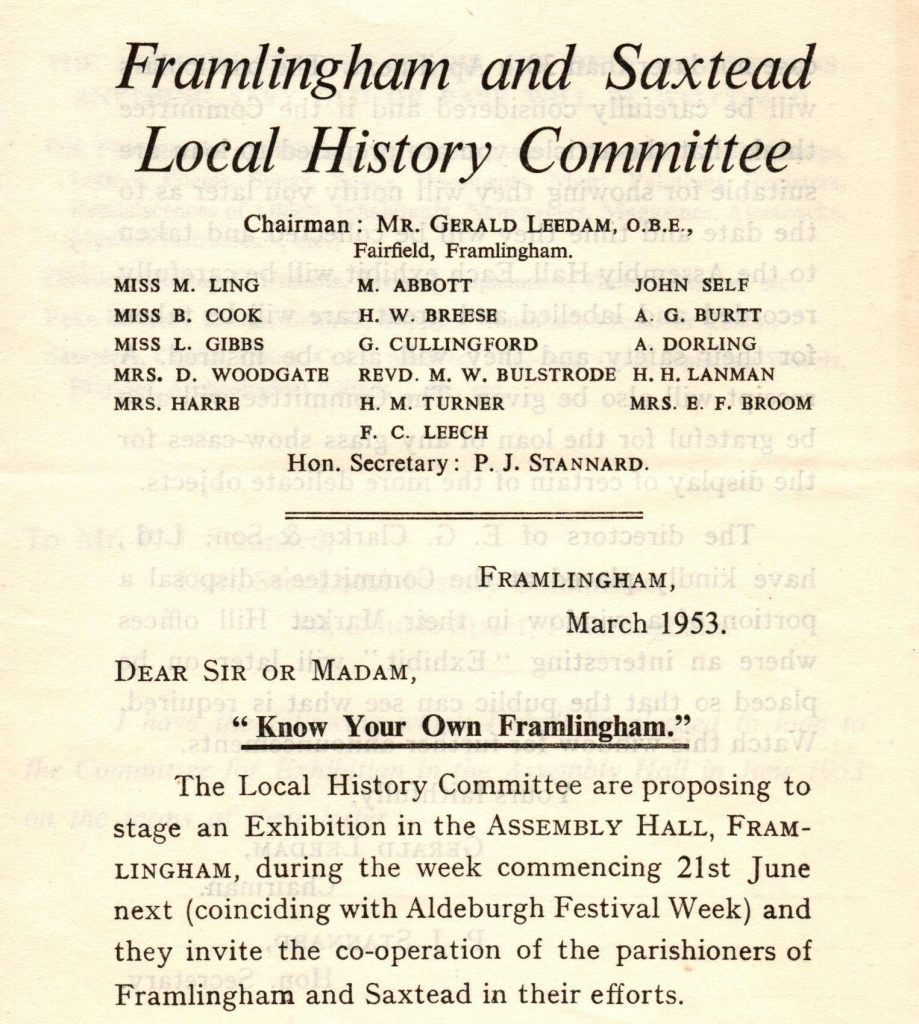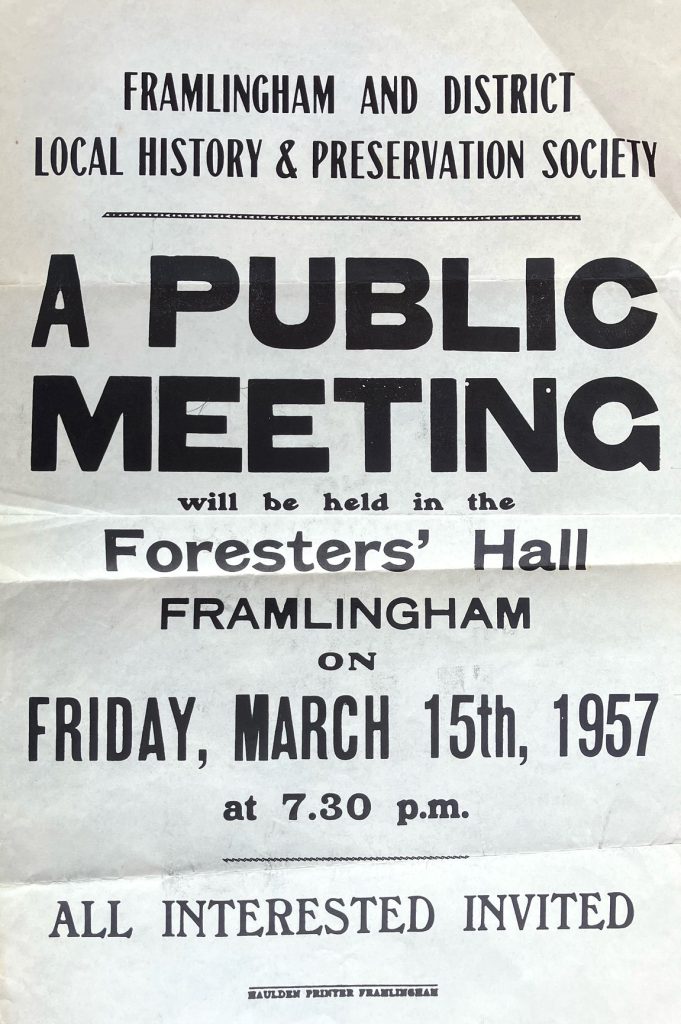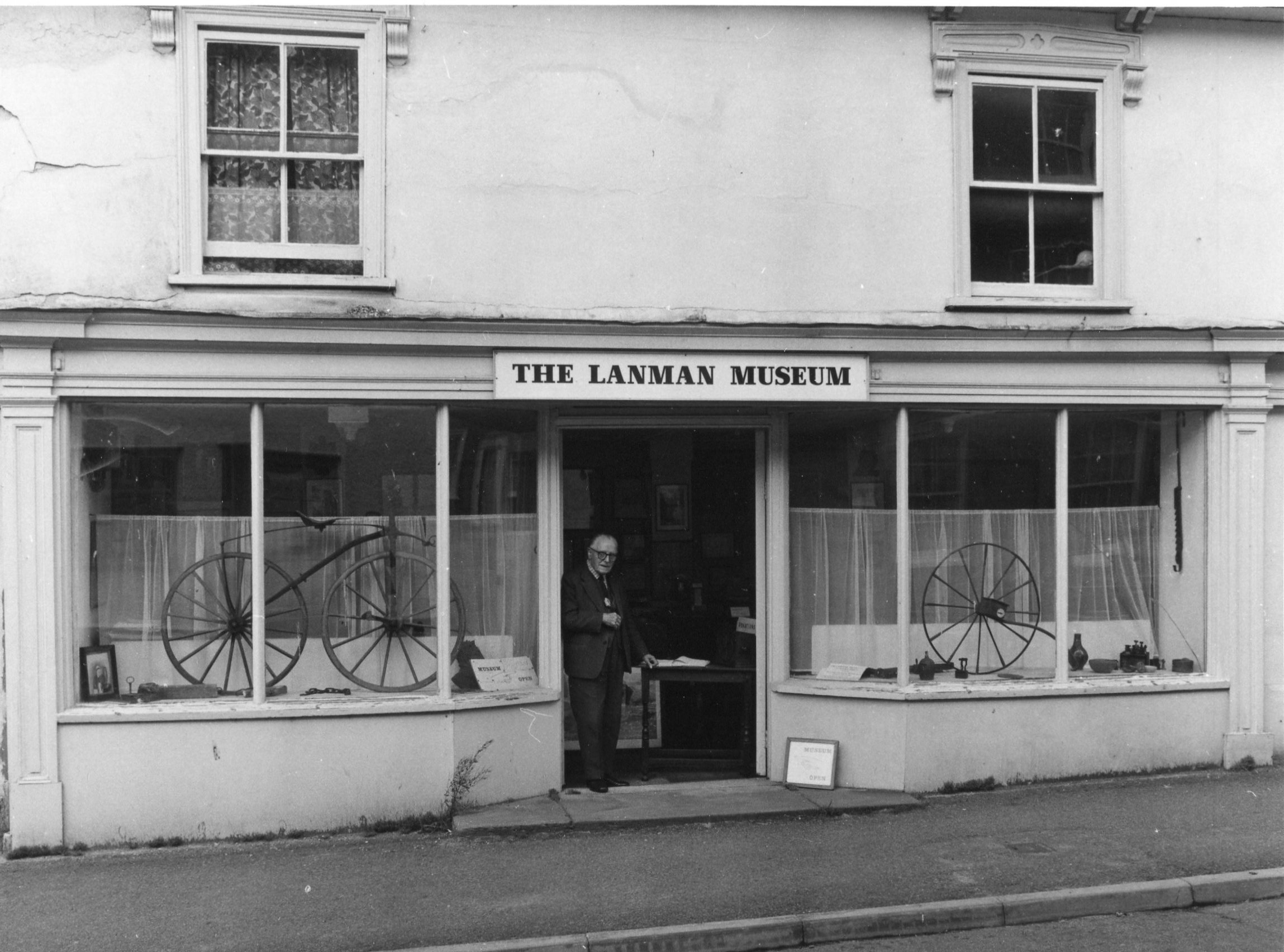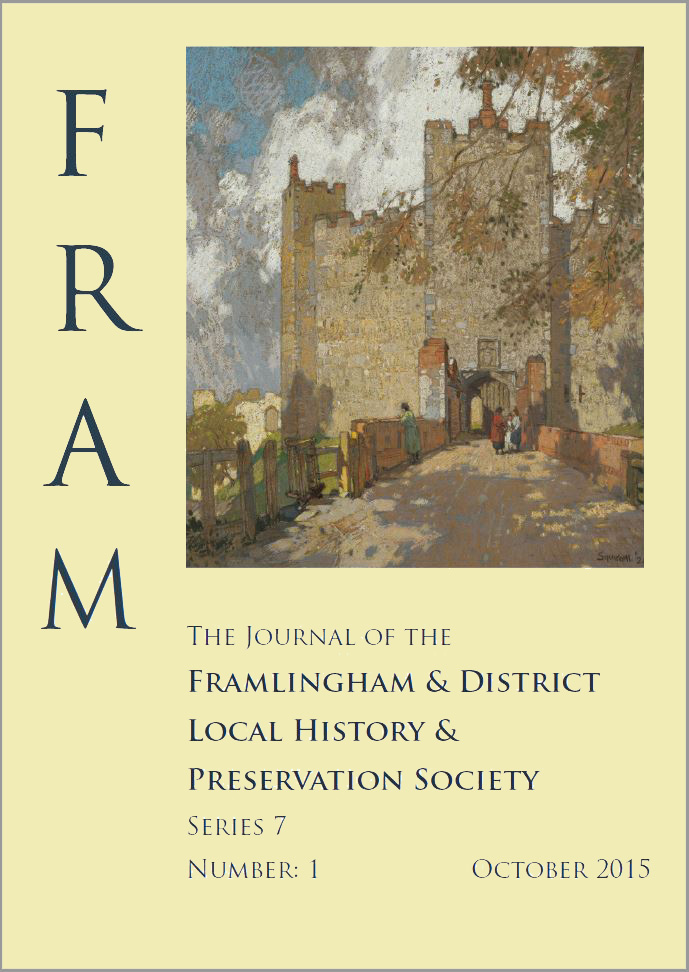Framlingham History Society (in full, the “Framlingham & District Local History & Preservation Society”) was created in 1956, but its origins can be traced back to 19531.

In that year, a committee was formed to stage a local history exhibition. See the attached leaflet that was circulated in and around the town. Key members of that committee were probably the secretary Percy Stannard and Harold Lanman. Percy Stannard was managing clerk of a firm of local solicitors, with unrivalled knowledge of Framlingham2. He did a great deal of local research, including into old inns of Framlingham3. Harold Lanman had maintained an antiques business at 8 Castle Street in Framlingham for many years, and was also a collector of artefacts, photographs and ephemera of the town4.
The exhibition was held in the Assembly Rooms at the top of Church Street, and was a grerat success (see the arcticle by John Bridges5). There were hundreds of items loaned to the exhibition ranging from a Roman coin to a De Dion Bouton motor car (loaned by Potters Motors). Many items came from Harold Lanman’s large collection.
The success of the exhibition led to the idea of a permanent museum, and Percy Stannard wrote to the Ministry of Works in 1955 to see whether a museum could be accommodated in the Castle. Any reply that might have been received has not survived. However, it was felt that an organisation was needed to protect and encourage interest in the town’s history. That organisation was formed, and the first constitution was established in 1956, and updated in 1973. The two main aims being summarised as follows:
- To encourage and foster interest and research in all matters relating to the history of Framlingham and surrounding areas.
- To provide and maintain suitable accommodation for all objects purchased, given or loaned to the Society.
A separate clause stated:
- Every endeavour shall be made to preserve historic objects, to maintain the existing amenities, and to prevent any threatened vandalism wherever it may be encountered.
This slightly strange form of words seems to encompass the ‘Preservation Society’ aspect of the full name. From the beginning there was always the intention that this historic town should be protected from “the wrong sort of development”, and the Society took a keen interest in planning isues in the town .

In March 1957 a meeting was held in the Forresters’ Hall (in Albert Road), to discuss options for a museum. The outcome must have been favourable, as a news cutting from later that year records the museum being opened on the Market Hill by The Earl of Cranbrook, who was the President. The location is now occupied by Ottie and The Bea.
For more information on the early years of the Society and the Museum see articles by Charles Seely6, Andrew Lovejoy7 and Bob Roberts8.
These premises were owned by Potters who only charged an annual rent of £2-12-0. (£2.60). Such a location was very desirable, but by 1969 it became necessary to move and the search was on for new premises.

These were found at No. 11 Double Street and the museum remained there for the next ten years. In that time it became the ‘Lanman Museum’ as the photos show his name over the door. After some time, commercial pressures came about as the premises needed to be sold. Everything would be packed up and moved to the Court House in Bridge Street.
The Committee felt the time had come for the museum to become a separate entity to the History Society, and so it became a new charitable organisation – The Lanman Museum9.
Professional design people were taken on board to design the exhibits and all the signage. Sadly, Harold Lanman died a short time before the opening. Although the museum and the layouts were good, it was always a struggle to obtain sufficient income that only came from visitors paying a small entrance fee. A good solution was to move the museum to the Castle, and English Heritage offered space there. The museum has been there ever since 1984.
The History Society continued to flourish, with winter lectures, summer visits10 and an annual dinner. In 1968, the first Newsletter was produced on stapled foolscap paper11, the editor being George Cooper, a man well versed in Framlingham history. Amongst many stories told, there is one where he recalled a Zeppelin passing over Framlingham in 1915 and dropping a bomb on what is now The Pageant Field. Recent investigation into this event showed his memory to be correct when the original incident report was found. These newsletters continued until 1974, and contain a wealth of information which would otherwise be lost.

In 1997, Bob Roberts, who had several roles in the Society including that of Chairman, introduced FRAM12, a most professional journal, which was initially published three times a year. It ran with quality upgrades to the printing and paper until 2020, when the costs of printing and postage, along with fewer articles for submission meant a new format was necessary. The result was the current form of electronic newsletter, which can be sent to our members at no cost in terms of printing or delivery. Hard copies are sent to members who cannot receive email. Although this has solved one problem, the lack of new content to publish still endures. In FRAM, members often sent letters to the editor which were published in the next issue. Our current members are encouraged to do likewise. Any snippets of information about their houses or early recollections of Framlingham in any period would be most welcome. Simply email them to framww2@gmail.com.
The Society was also involved with several projects. In 1999, the large hoist on the Carley and Webb building was restored through the efforts of Tony Martin. He was also instrumental in getting the blue plaque for Sir Henry Thompson13 manufactured in 2004. It is located over the St Elizabeth Hospice shop on the Market Hill, where his father had his grocery and drapery store. The Millennium project was to commission a plaque to commemorate Mary Tudor’s accession in 1553, having been proclaimed Queen while at Framlingham castle14. The plaque was unveiled by the Earl of Surrey and was located in the main castle hall. In recent years, the plaque has been on various journeys and suffered in the process. It has now been restored and has found a permanent home in the Lanman Museum.
Over the years, there have been many excellent speakers at our winter talks, all organised by Charles Seely, our Hon. Secretary. One in particular was George Ewart Evans whose impact on recording Suffolk agricultural and village life was second-to-none. His many books bear testimony to his work. At the Society’s AGM on Wednesday 27 November 2024, the film made by him in 1980, entitled ‘A Writer’s Suffolk‘was shown.
There is so much more that could be said about the History Society and all the people who made it a success over the years. In order to keep it going though, we really do need to attract new committee members. If you would like to be involved, please speak to us at the next meeting, or email us. Visit http://framlinghamhistory.uk for details.
Footnotes
- This article is based on previous articles and talks especially by John Bridges, and also by Charles Seely, Andrew Lovejoy and Bob Roberts. These are referenced individually as relevant. ↩︎
- See also “Percy Stannard Recollections”, FRAM Journal Series 7 Number 1, October 2015, p6. ↩︎
- See “Former Inns of Framlingham” on this website. ↩︎
- See https://lanmanmuseum.uk/about-us/harold-lanman/ ↩︎
- See “A Brief History of the History Society”, John Bridges, FRAM Newsletter No. 10, Oct 2024, p7 ↩︎
- See “The Framlingham and District Local History and Preservtion Society – The First Fifty Years”, Charles Seely, FRAM Journal Series 5 No. 12, April 2009, p4. ↩︎
- See “The Lanman Museum”, Andrew Lovejoy, FRAM Series 3 No. 3, Apr 1998 p7 ↩︎
- See “The Town’s Museum: a File Note”, Bob Roberts, FRAM Journal Series 4 No. 2, Dec 2001, p23 ↩︎
- See The Lanman Museum website. ↩︎
- See the society’s programme. ↩︎
- Contents of these earlier newsletters can be found here. ↩︎
- The contents of FRAM journals and later newsletters can be found here. ↩︎
- For more about Sir Henry Thompson see here. ↩︎
- For more on Queen Mary’s proclamation as Queen while in Framlingham Castle see here. ↩︎
